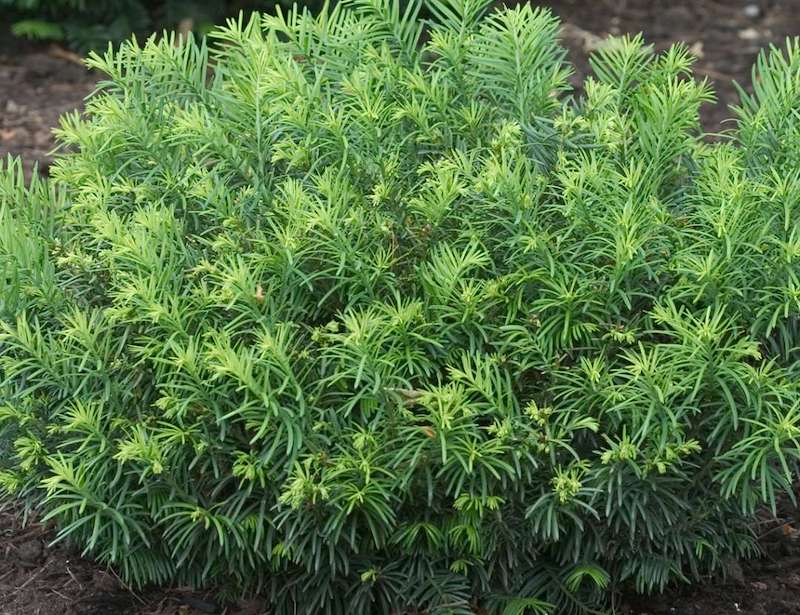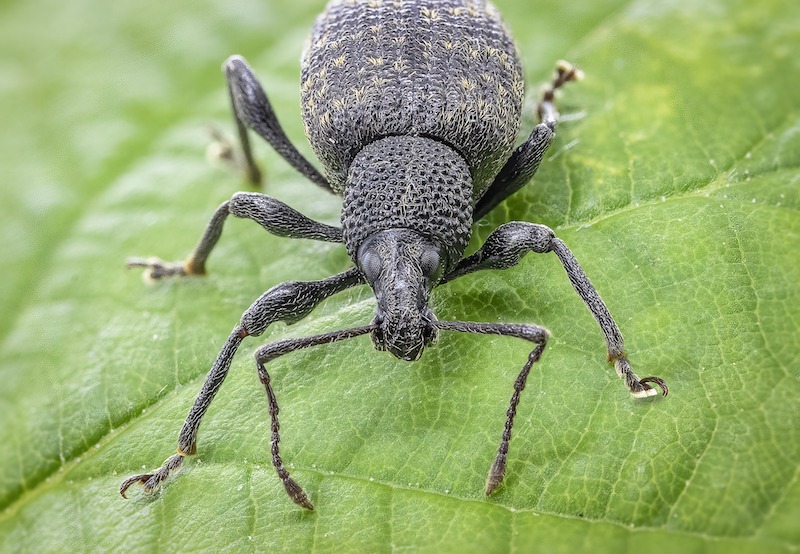Yews are often prized as landscape specimens for their attractive form and evergreen foliage, so it can be alarming when damage appears on needles or branches. Damage can range from obvious chewing to discoloration, needle drop, and overall plant decline. Several different pests could be responsible for damage to yews. Routine inspection and early detection of damage will help to correctly identify the pest responsible for damage before an infestation becomes too severe. It will also guide treatment decisions. The most likely culprits behind yew damage include black vine weevils, scales, mealybugs, deer, and mites.

Common Yew Pests
Black Vine Weevil
Both adult and larvae of black vine weevil can damage yews with their feeding. The adult black vine weevil is a 0.5-inch long dark beetle with a snout and patches of white on its forewings. Adults emerge in spring and at night and chew on needles, leaving them clipped and ragged. Larvae are about a 0.5-inch long, legless, and assume a C-shaped posture when they are disturbed. The larvae hide in the soil and feed on roots of yews. Eggs, found in the soil around the base of plants, are round and pale orange in color. The feeding larvae are the most concerning, as they can seriously weaken the plant and leave it vulnerable to root rot.
Treating Black Vine Weevil on Yew
Handpicking and destroying adults when they appear early in the growing season will keep larvae in check later. Where chemical control is desired, monitor the yew for the first sign of adult chewing. About a week after the adult weevils are observed, spray the yew foliage with spinosad. Spinosad is not long lasting, so repeat the application about 7 to 10 days after the first spray. Keeping the yew healthy with occasional watering when necessary and spring feeding will encourage recovery from and tolerance of black vine weevil feeding.
Preventing Black Vine Weevil on Yew
The adult beetles move to new plants by walking, not flying, so barriers can be an effective management tool between infested and clean plants. Prune yews so that branches are not touching other nearby plants or the ground to prevent bridging. Wrap the trunk or stems with landscape fabric or tree wrap, then coat it with a sticky trapping substance like tanglefoot. Parasitic nematodes applied as a drench around the base of the plant also help to control larvae. Check the roots of any new plants for signs of black vine weevil before bringing them into the landscape.

Mealybugs
Mealybugs are often first noticed on a yew or other plant when they appear en masse as a clump of white, cottony material. These insects tend to congregate on needles and stems, so may not be noticed singly when numbers are still small. Adult female mealybugs are soft-bodied, wingless insects less than one-fifth inch long and are covered with a whitish, mealy wax. The slow-moving adult females feed and return to protected places like under bark to lay eggs. Mealybugs feed on stems and leaves. In large numbers they slow plant growth and can cause needle and twig dieback. They also excrete honeydew as a byproduct of feeding, which hosts the development of unsightly black sooty mold.
Treating Mealybugs on Yew
Mealybug populations may naturally drop in summer, and beneficial insects often offer the most effective control to keep mealybugs in check. However, where numbers are so large that a prized plant is suffering, additional treatment is warranted. A forceful stream of water sprayed over the plant can knock many mealybugs off. Insecticidal soap or horticultural oil sprayed directly on this pest is the next least intensive option. Finally, if a contact spray is having little impact, consider using a systemic insecticide that the yew will take up through its roots.
Ants feed on the honeydew that mealybugs produce and will protect the mealybugs from their natural enemies. It may be necessary to control ants to allow mealybug predators and parasites to bring mealybug numbers under control. Fertilize the yew annually in spring with a slow-release, complete fertilizer.
Preventing Mealybugs on Yew
It is much easier to prevent mealybug outbreaks and keep pest numbers in check with good care practices than it is to treat a severe infestation. Keep the yew healthy with proper care practices that include occasional irrigation during periods of extended drought, avoiding excessive nitrogen fertilizer applications, and avoiding pruning midsummer and later.
Scales
Multiple species of scales can occasionally bother yew plants in the landscape. Geographic area plays a role in determining which scale species is likely to become a pest on yews. Adult, female scales are the most noticeable on plants, appearing as small, immobile bumps on needles. Scales use piercing mouthparts to suck fluids from the yew. As a result of feeding, scales excrete honeydew, a sticky, shiny substance that also hosts the growth of black sooty mold. Often this honeydew is the first symptom of feeding, followed by plant discoloration and overall decline. Crawlers are the immature life stage of scales; they are small, mobile, and often hard to spot but are more vulnerable to treatment than adults.
Treating Scale on Yew
Where an infestation is minor or contained to a few branches of a plant, simply pruning out the worst areas can provide adequate control. When scales build up and chemical treatment is justified, there are two options: systemic or contact treatments. A systemic insecticide like imidacloprid drenched in the soil around the yew is absorbed by the plant and controls scales as they feed. Spraying the crawlers when they are active in late spring and early summer with a horticultural oil, insecticidal soap, or other insecticide labeled for scales will significantly knock down the scale population. Good care practices will help the yew withstand some amount of scale activity without problem and encourage recovery.
Preventing Scale on Yew
It may be very difficult to completely prevent the presence of scale in the landscape. However, healthy plants can typically withstand some amount of scale activity, and natural predators will help to control these pests if they are also in the landscape. Overfertilization and excessively vigorous new growth encourages scale buildup. Because ants feed on the honeydew that scales produce, they will protect the scales from natural predators and parasites. So, controlling ants may be necessary to prevent scale infestations.
Deer
Yews are sometimes severely damaged by deer. Unlike most mammals, yew is not toxic to them. Feeding damage is most prevalent in mid or late winter when other food is scarce. Deer eat whole sections of foliage and twigs, with damage typically occurring overnight and quickly. While the damage to yews can be quite extensive, it is often possible for yews to recover and thrive after deer feeding.

Treating Deer Damage
Following deer damage to yew, the best course of action is to take steps to prevent further feeding on the yew followed by care practices that will help the yew to recover. In late winter to early spring, prune the yew to tidy it up and even up the shape of the plant to hide damage. In spring, apply a slow-release, balanced fertilizer for evergreens over the root zone at the rate recommended by the fertilizer manufacturer. Check the soil around the yew regularly during dry spells. Whenever the soil feels dry a few inches below the surface, water the yew deeply and slowly.
Preventing Deer Damage
Deer typically feed on yews in winter only when other food becomes scarce. It is possible to prevent deer damage with physical barriers or using repellents. Pounding stakes into the ground just outside of the yew’s spread and wrapping snow fence, deer fence, or burlap around the perimeter of the stakes can keep deer from approaching the yew and feeding. This method can be labor intensive and might not be feasible in areas with high visibility. Foul-smelling repellents are commercially available; these are sprayed on the foliage of yews and other attractive plants 1 to 2 times per month in the winter or after major precipitation events.
Sources: "Yew (Taxus)." Connecticut State - The Connecticut Agricultural Experiment Station. portal.ct.gov
 |
Author Angela Ryczkowski - Published 4-15-2023 |
